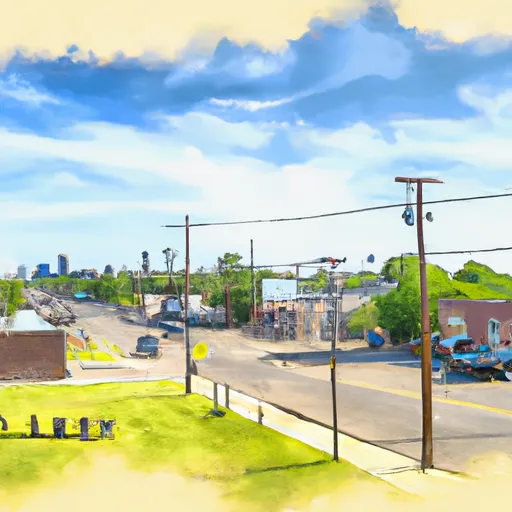-
 Snoflo Premium
Snoflo Premium
Get unlimited access to all our content
With no Ad interruptions! - Start Your Free Trial Login with existing account
Durant
Eden Index
Climate
9.8
•
Recreation
5.1
•
Community
1.9
•
Safeguard
6.2/10

Durant, Oklahoma has a humid subtropical climate, characterized by hot and humid summers and mild winters with occasional snowfall. The city is located in the Kiamichi River basin, which provides a variety of hydrology constituents, including surface water from Lake Texoma and groundwater from the Arbuckle-Simpson Aquifer. Outdoor recreation opportunities in Durant include fishing, boating, and swimming in Lake Texoma, hiking and camping in nearby state parks such as Lake Murray and Tishomingo, and exploring the trails and waterfalls of the Chickasaw National Recreation Area. The city is also home to several golf courses and hosts the annual Magnolia Festival, which features live music, food vendors, and carnival rides.
What is the Eden Index?
The Snoflo Eden Index serves as a comprehensive rating system for regions, evaluating their desirability through a holistic assessment of climate health, outdoor recreation opportunities, and natural disaster risk, acknowledging the profound impact of these factors on livability and well-being.
Climate Health Indicator (CHI): 9.8
Durant receives approximately
1133mm of rain per year,
with humidity levels near 75%
and air temperatures averaging around
17°C.
Durant has a plant hardyness factor of
7, meaning
plants and agriculture in this region tend to thrive during the non-winter months.
By considering the ideal temperature range, reliable water supplies, clean air, and stable seasonal rain or snowpacks, the Climate Health Indicator (CHI) underscores the significance of a healthy climate as the foundation for quality living.
A healthy climate is paramount for ensuring a high quality of life and livability in a region, fostering both physical well-being and environmental harmony. This can be characterized by ideal temperatures, reliable access to water supplies, clean air, and consistent seasonal rain or snowpacks.
Weather Forecast
Streamflow Conditions
Red-Little
Area Rivers
Red-Little
Snowpack Depths
Red-Little
Reservoir Storage Capacity
Red-Little
Groundwater Levels
Recreational Opportunity Index (ROI): 5.1
The Recreational Opportunity Index (ROI) recognizes the value of outdoor recreational options, such as parks, hiking trails, camping sites, and fishing spots, while acknowledging that climate plays a pivotal role in ensuring the comfort and consistency of these experiences.
Access to outdoor recreational opportunities, encompassing activities such as parks, hiking, camping, and fishing, is crucial for overall well-being, and the climate plays a pivotal role in enabling and enhancing these experiences, ensuring that individuals can engage in nature-based activities comfortably and consistently.
Camping Areas
| Campground | Campsites | Reservations | Toilets | Showers | Elevation |
|---|---|---|---|---|---|
| Dam Site | None | 560 ft | |||
| Newberry Creek Resort and Marina | None | 627 ft | |||
| Willow Springs - Lake Texoma | None | 647 ft | |||
| Boggy Depot Park | None | 594 ft | |||
| West Burns Run - Lake Texoma | None | 632 ft | |||
| Lakeside - Lake Texoma | None | 632 ft | |||
| Platter Flats - Lake Texoma | None | 646 ft | |||
| Willafa Woods - Lake Texoma | None | 634 ft | |||
| Johnson Creek - Lake Texoma | None | 656 ft | |||
| East Burns Run - Lake Texoma | None | 661 ft |
Nearby Fishing
Catastrophe Safeguard Index (CSI):
The Catastrophe Safeguard Index (CSI) recognizes that natural disaster risk, encompassing floods, fires, hurricanes, and tornadoes, can drastically affect safety and the overall appeal of an area.
The level of natural disaster risk in a region significantly affects safety and the overall livability, with climate change amplifying these risks by potentially increasing the frequency and intensity of events like floods, fires, hurricanes, and tornadoes, thereby posing substantial challenges to community resilience and well-being.
Community Resilience Indicator (CRI): 1.9
The Community Resilience Indicator (CRI) recognizes that education, healthcare, and socioeconomics are crucial to the well-being of a region. The CRI acknowledges the profound impact of these elements on residents' overall quality of life. By evaluating educational resources, healthcare accessibility, and economic inclusivity, the index captures the essential aspects that contribute to a thriving community, fostering resident satisfaction, equity, and social cohesion.

